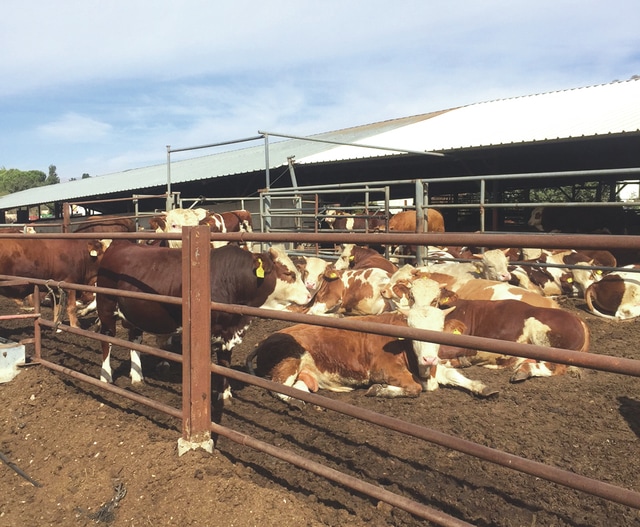
DARKE COUNTY — If all goes according to plan, generations of cattle in Israel will retain a lifelong connection to the Buckeye State.
In November, Darke County native Larry Baker, director of the Ohio Livestock and Genetics Export Council, took a trip to Israel, accompanied by Dr. Emily “Em” Mowrer, veterinarian and owner of Stonehouse Veterinary Service, to oversee the implantation of beef cattle embryos, purchased from Ohio cattle producers and others, into indigenous livestock.
The seeds of the mission were planted in May when two Israeli cattle ranchers — Erez Cahaner and Thierry Moens — visited with Baker to tour Ohio cattle ranches with an eye toward selecting embryos for transport to the Holy Land. The two hope to create a “branded” beef product in Israel, much like Americans have become accustomed to characterizations such as “Angus beef.”
“They will have a branded product, as I understand, that will be from farm to plate,” Baker said.
The cow embryos transported to Israel included ones from Darrell Dickinson Longhorns of Barnesville, Belmont County, and John Grimes’ Maplecrest Farm in Hillsboro, Highland County. Other embryos originated from Montana and Texas. In all, the venture cost the buyers more than $50,000.
Dr. Mowrer said embryos were implanted in approximately 40 cows.
“I was very impressed with the farm where we implanted the embryos,” she said. “They are proud of their livestock, and do a great job vaccinating and preventing diseases that are common in Israel. I was surprised by some of challenges that producers face due mostly to ticks and a scarce water source.”
Baker said he was initially curious as to why the Israelis wanted to crossbreed indigenous stock with longhorn embryos, but found that longhorns are much better suited for the hotter, dryer climate there, as well as protection from predators, such as wolves.
“Longhorns can live on a lot less than English breed cattle,” he said. “Once I saw the harsh conditions the cattle there have to be raised in, I can understand it.”
Baker said the visit also helped clear up misconceptions some may have regarding dietary habits in Israel, particularly as it pertains to the consumption of beef.
“I was under the impression that everything there was kosher,” he said. “But that’s far from the truth. I’d say the majority of the Jewish population do not follow strict kosher rules. That was kind of surprising.”
Baker, who has traveled to more than 36 countries over the past 25 years, says the export group’s goal is not only transporting a product, but also expertise, especially for less technologically advanced agricultural regions, such as Vietnam or China.
“The biggest thing I see, everybody gets all hyped up to send live cattle, but without studying the nutrients available or the management practices — a lot of them don’t have that ability,” he said. “So essentially, it fails right off the get-go.”
“We like to sell genetics, but also you have to consider their ability to manage it,” Baker added.
The Buckeye state is a top exporter of all types of agricultural products to places around the globe, from corn to soybeans to pork and eggs. The export of genetic materials, however, is also a little-publicized, but profitable, trade venture that reaps rewards for Ohio’s ag community.
“Ohio is either number one or number two in the export of genetics and germ plasma, which is semen or embryos. We trade back and forth with Wisconsin,” Baker said, claiming he is mystified by this being such a “closely guarded secret.”
All in all, Baker says he is “very optimistic” about the Israel venture and its future benefits, both for that country and for Ohio agriculture.
Mowrer called her trip to Israel was one of the most “meaningful trips” she’s been on.
“The cattlemen I met in Israel are extremely proud of their farms,” she said. “Their enthusiasm to produce a high-quality beef product from their livestock is really something special. These are educated, excited producers who are eager to learn and also to spread their knowledge to neighboring farmers. I was encouraged by how helpful they are to each other, and how supportive and caring they are regarding their livestock.”
Cattle operations in Israel were not the only thing that caught her attention, agriculturally speaking.
“We also saw a sheep dairy and some olive and citrus orchards,” she explained. “The agriculture systems in the country are varied and well-run.”
Like Baker, Mowrer is optimistic regarding the prospects of success of the project.
“I feel that the success of the project should be pretty good. We all learned from the process and have some ideas in mind to assist us with future projects,” she said.
She also provided high praise for Ohio livestock producers.
“We should all be proud of our products and begin to think outside the box more for marketing both livestock and embryos. We have a great agricultural system in Ohio, and we should be eager to pass along our skills and knowledge.”


